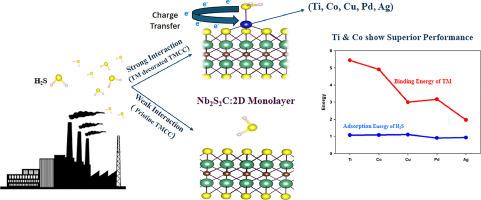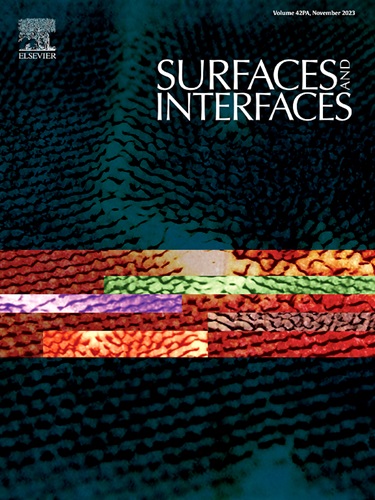揭示新合成的二维 TMCC 单层在 H2S 气体传感方面的潜力:DFT 研究
IF 5.7
2区 材料科学
Q2 CHEMISTRY, PHYSICAL
引用次数: 0
摘要
过渡金属碳二钙化物(TMCC)的二维单层最近已从其块状形态合成出来。它是 MXenes 和过渡金属二钙化物 (TMDC) 的独特混合物,与单个母体成分相比具有更优越的性能。TMCC 在气体传感应用方面的潜力尚未得到开发,这促使我们研究它在检测 H2S 气体分子方面的性能。原始单层 TMCC(Nb2S2C)表现出很弱的 H2S 吸附能(-0.18 eV),导致灵敏度低、选择性差,因此需要进行表面改性。通过考虑过渡金属 (TM) 原子,如 Ti、Co、Cu、Pd 和 Ag,采用了装饰策略。钛和钴装饰的 TMCC 表现出卓越的 H2S 气体传感性能。钛的结合能最大(-5.44 eV),其次是钴(-4.91 eV)。H2S 在钛和钴装饰 TMCC 上的吸附能相当,分别为 -1.08 eV 和 -1.09 eV,而在 350 K 下的实际恢复时间分别为 6 秒和 8.5 秒。吸附机制的改善是由于轨道相互作用和电荷转移。研究还评估了功函数灵敏度和高达 400 K 的热稳定性。研究表明,钛和钴装饰的 TMCC 单层是 H2S 传感的合适候选材料,这激励实验人员制造基于 TMCC 的 H2S 传感器。本文章由计算机程序翻译,如有差异,请以英文原文为准。

Unveiling the potential of newly synthesized 2D TMCC monolayer for H2S gas sensing: A DFT study
The 2D monolayer of transition metal carbo-dichalcogenide (TMCC) has been recently synthesized from its bulk form. It is a unique blend of MXenes and transition metal dichalcogenides (TMDCs), offering superior properties compared to its individual parent components. TMCC has not yet been explored for its potential in gas sensing applications, motivating us to investigate its performance for detecting H2S gas molecule. The pristine monolayer of TMCC (Nb2S2C) exhibited weak H2S adsorption energy (-0.18 eV), leading to low sensitivity, poor selectivity, underscoring surface modification. The decoration strategy was incorporated by considering transition metal (TM) atoms like Ti, Co, Cu, Pd and Ag. Ti and Co decorated TMCC showed superior H2S gas sensing performance. Ti showed maximum binding energy (-5.44 eV) followed by Co (-4.91 eV). The adsorption energy of H2S on Ti and Co decorated TMCC were comparable having values of -1.08 eV and -1.09 eV respectively while showing respective practical recovery time of 6 s and 8.5 s at 350 K, respectively. The improved adsorption mechanism is due to orbital interaction and charge transfer. Work function sensitivity and thermal stability upto 400 K was assessed. The study shows Ti and Co decorated TMCC monolayer as a suitable candidate for H2S sensing, inspiring experimentalists to fabricate TMCC-based H2S sensors.
求助全文
通过发布文献求助,成功后即可免费获取论文全文。
去求助
来源期刊

Surfaces and Interfaces
Chemistry-General Chemistry
CiteScore
8.50
自引率
6.50%
发文量
753
审稿时长
35 days
期刊介绍:
The aim of the journal is to provide a respectful outlet for ''sound science'' papers in all research areas on surfaces and interfaces. We define sound science papers as papers that describe new and well-executed research, but that do not necessarily provide brand new insights or are merely a description of research results.
Surfaces and Interfaces publishes research papers in all fields of surface science which may not always find the right home on first submission to our Elsevier sister journals (Applied Surface, Surface and Coatings Technology, Thin Solid Films)
 求助内容:
求助内容: 应助结果提醒方式:
应助结果提醒方式:


